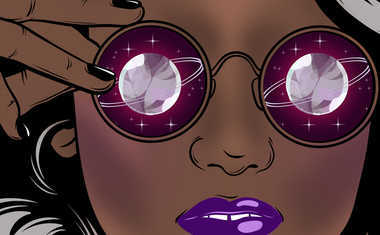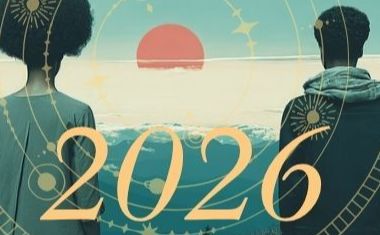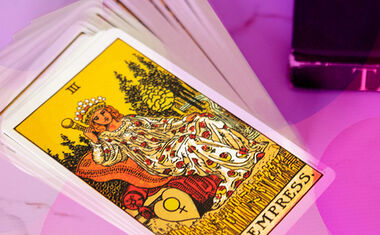
The English Magic Tarot Deck
Understanding its deep history
Content provided by Andy Letcher of the English Magic Tarot deck
Magic, like coffee, wakes you up and helps you get things done. Like music, magic is a universal language that works with powers that exist within each of us. Rituals, talismans, trances, spells -- the tools and techniques that magicians use to achieve their ends -- are many and varied, but there is one tool which has proved remarkably effective for both the seasoned magician and for those who have very little knowledge or experience of the subject: the Tarot.
The Tarot emerged out of Renaissance Italy in the 14th century, but it was in England, at the end of the 19th century, that magicians first began to use the Tarot in a precise, magical way that went beyond the use of it as a fortune-telling device.
The English Magic Tarot deck builds on these centuries-old Tarot traditions, but it does something more than that. It invites a whole host of images and ideas into its cards; energies that come from the colorful history of English magic.
Get a Celtic Cross Reading using the English Magic Tarot deck now!
What is English magic?
English magic is a distinctive, local branch of natural magic. It has evolved through many iterations, from prehistoric times to the present day, and freely blends high and low magic (more on this later). English magic regards the cosmos as animate, and our place in the world as significant. It calls us to rediscover a magical connection with the land upon which we happen to live, whether that be England or elsewhere. It supposes that through practice and study, we can attain a greater understanding of the disparate parts of the self, and the magical connections that permeate the universe. Through English magic we can attain a true knowledge of the world.
Traditionally, there are two kinds of magic. Demonic magic is concerned with the conjuration
of demons or spirits to do a magician's bidding. For obvious reasons, it's gotten bad press over the years, and, as messing with demons is a risky affair, most magicians have avoided it.
Alternately, natural magic assumes that the world is full of forces, or connections of cause
and effect, that happen to be hidden or "occult." In learning to manipulate those connections (for example, by making the right talisman or performing the appropriate ritual), the natural magician can send change coursing out through the world, and so affect the way things unfold. Divination, through a system like the Tarot, is seen as a particularly good way to discover these hidden forces, with each reading serving as a kind of snapshot of the divine energy as it manifests in the world.
Magic is universal. English magic is simply the English dialect of a language that's shared by all human cultures. It is a particular, regional way of doing it. It stands to reason that if magic is natural, then it will be shaped by the land it belongs to and the language and culture of the people
living there.
The foundations of English magic go right back to the earliest days, to the architects who aligned Stonehenge to the midwinter sunset, to the Druids with their ogham tree lore, and to the early Anglo-Saxons with their runes. The traces of our ancestors' magical practices lie etched across -- and buried within -- the English landscape, and if you look carefully you'll see those traces in The English Magic Tarot cards, too.
High and low magic
Two streams, or currents, run through English magic: one is high or learned magic, which traces its roots all the way back to Hellenistic Egypt. High magic incorporates astral magic, the Cabbala, and a good smattering of Neo-Platonic philosophy. Consequently, it requires much book learning and extremely complicated rituals, performed with exacting precision at the correct astrological time, with the correct incense, with the right ritual tools, and so on.
Low magic, however, is the magic done by ordinary folk, consisting of a body of lore and practices that have simply emerged through the passage of time, handed down through the generations. Practitioners of low magic were called cunning men and women.
The streams of high and low magic cross repeatedly through the history of English magic -- Wicca, for example, mixes both -- and they also cross in the Tarot. On one hand, the cards have been traditionally used in that classic low magic kind of a way as an oracle to read people's fortune at psychic fairs and in Romany caravans. On the other, 19th century magicians come to see the Tarot, with its synchronistic numerical correspondences to the Cabbala, as the key to unlocking the secrets of high magic. The Tarot deck that has come to be the most popular, the Rider-Waite deck, is replete with Cabalistic imagery.
Telling your story
The Tarot consists of a set of archetypal images, meaning that each is a potent, super-condensed story, brimming with possibility. When we use the Tarot, when we lay the cards out in a spread, we are presented with a unique arrangement of these elements, an arrangement that tells a bigger story -- our story. We see our inner narratives reflected back to us in the narratives laid out in the cards. Then, you can change the way the stories go. You can cause change to occur in accordance with will.
The English Magic Tarot invites you to enter into its world, and to trust it to work its magic on you.
Get a Celtic Cross Reading using the English Magic Tarot deck now »



